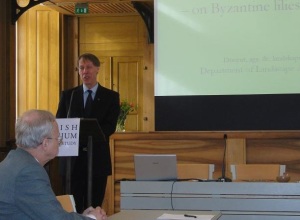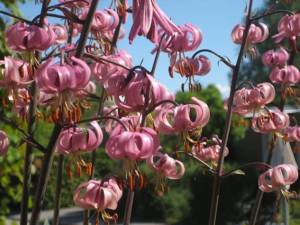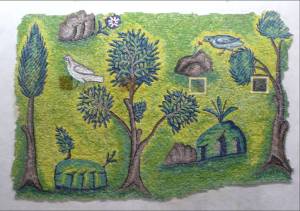On Byzantine gardens in images and words (Uppsala 7-8 April 2011)
av Ingela Nilsson
In early spring, a small group of scholars met in the Botanical garden in Uppsala. They had been invited by NBN to a symposium entitled “Byzantine Gardens and Beyond”, and The Swedish Collegium for Advanced Study (SCAS) generously put their lecture hall at our disposal.
The symposium opened with an evening lecture held by Antony Littlewood (University of Western Ontario). In a number of important publications on Byzantine gardens, Littlewood has previously explored the theme from various angles. His rich lecture now took the audience from the gardens of Roman villas to the fruit yards of Byzantine estates and the luxurious gardens of the Great Palace, now hidden beneath modern Istanbul. He showed us how the combination of literary, iconographic and archeological evidence help us come up with a surprisingly full image of what the Byzantine gardens were like and how they were perceived by the Byzantines themselves. Somewhat dazzled by the wealth of images and information, the participants could then enjoy the reception arranged by the Collegium.

Björn Wittrock opens the second day of the symposium with some reflections on gardens (in the foreground Per-Arne Bodin)
With a point of departure in Littlewood’s opening lecture, the following day was devoted to moving beyond the gardens of Byzantium themselves and exploring the topic from new angles. Björn Wittrock, principal at SCAS, opened the morning session by reminding us of the garden’s significance as a place for reflection on the self and on others – a vital space for human experience, and with crucial temporal dimensions.
The next two scholars explored Scandinavian relations to Byzantine gardens from the perspective of landscape architecture and botany. Kjell Lundqvist (Swedish University of Agricultural Sciences, Alnarp) discussed red and white lilies from Constantinople (Lilium album Byzantinum and Lilium rubrum Byzantinum), their origin – indeed their existence – and their journey from Byzantine territory to the North (
Unfortunately, Kjell could not attend the symposium and his paper was therefore read by Ragnar Hedlund, accompanied by wonderful photos of lilies, red and white.).
Red lilies from Byzantium? Photo by Kjell Lundqvist.
Inger Larsson (Stockholm University) looked at medieval Swedish plants and plant-names, showing us how some of them indeed originate from Byzantium.
Leaving the real gardens and plants, Helena Bodin (Stockholm University) took us to the symbolic gardens of Byzantine hymnography, exploring in particular some of the hymns praising the Theotokos (Mary) as a garden. Moving on to yet another perspective, Jørgen Bakke (University of Bergen) brought in the concept of cultural memory and discussed landscape and memory in the Greek-Orthodox tradition, emphasizing the mental plan rather than the actual image of the Byzantine garden.
The two final papers explored Byzantine gardens from the perspective of symbol and reception.
Olof Heilo (University of Vienna) looked at paradise as a garden beyond the physical garden in his exploration of Umayyad culture, pointing at the meeting and merging of secular and Christian motifs in the garden theme. Per-Arne Bodin (Stockholm University) focused on another period and a different material, namely medieval Russian culture, but his paper too discussed the earthly paradise and the symbolic use of the garden motif.
In this way the speakers of the symposium took us through time and space, from Rome to Constantinople and further on to Syria, Russia and even the cold North. It became very clear that gardens for ages have provided artists, writers and thinkers with a never-ceasing stream of inspiration.
The papers of the symposium are now under revision for a volume to be published in Studia Upsaliensia Byzantina, edited by Helena Bodin and Ragnar Hedlund. NBN is looking forward to the release party and would like to take this opportunity to thank SCAS and Riksbankens jubileumsfond for their generous support.
A Byzantine garden as it really looked like? Mosaic in S. Apollinare in Classe, Ravenna, 549 AD.
(Originally published on September 11, 2011)



